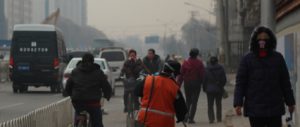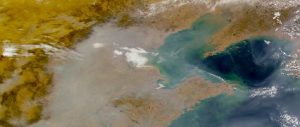The day I turned my attention to this article, Beijing had once again disappeared under a shroud of smog. Distant buildings loomed in and out of the mist, the sun shone hazily and a faint smell of burning hung in the air. The myriad of channels posting pollution data online indicated that pollution levels were very high, and advised against vigorous outdoor activity.
For most workers, it is hard to heed this advice. As always, they dash around the city, going about their business, while children – the people most vulnerable to the hidden dangers of air pollution – play in the yards of their housing estates or take part in routine winter long-distance running in school sports grounds. This brings to mind another smoggy day when I tried to dissuade a child from going outside to play football. He wasn’t at all appreciative of my gesture, and said very seriously: “But we’ve already developed super-strong immunity. We’re used to it.”
Is it really possible to get used to it? Perhaps it’s true that long-term exposure to a polluted environment can increase tolerance, limiting the body’s stress response. In 2009, a pilot smog-monitoring scheme run by China’s environmental protection authorities discovered that in cities including Tianjin, Shenzhen, Chongqing, Shanghai, Suzhou and Nanjing, the number of smoggy days ranged from 51 to 211 in a single year. While new visitors from abroad often complain that the unclean air in Chinese cities causes them respiratory complaints, the millions of people who live here all the time appear to get on with life as normal.
But is it really “normal”? Studies have shown the smog is largely made up of PM 2.5, fine particulate matter with a diameter of 2.5 microns or less. The impacts of this pollutant aren’t limited to reducing atmospheric visibility: PM2.5 can also penetrate multiple barriers in the human body, seeping into the lungs, entering the blood through the alveoli and directly harming human health. Beijing’s lung cancer rates have risen by 60% over the last 10 years. In the words of Zhong Nanshan, an academician at the Chinese Academy of Engineering, because of air pollution, “everyone over the age of 50 in Guangzhou has black lungs!”
These days, I often travel abroad for work. When I fly over international cities such as London, Paris, New York, San Francisco, Tokyo and Melbourne, it isn’t the skyscrapers my fellow countrymen so admire that affect me most deeply, but the clearness of the air. As the earth below comes into view, rivers, lakes, forests and meadows are vivid; street blocks, buildings, and vehicles clear and distinct. And I begin to fantasise about a day in the future when my city’s air is also clean.
On the morning of that day, you won’t wake up with a sore throat. You’ll be able to throw open the window and let the refreshing breeze into your room, breathing deeply without worrying that PM2.5 is penetrating your lungs. You’ll be able to change into a pair of trainers and go for a morning jog in the sunlight, without worrying that the exercise may be doing you more harm than good. Just as if you were in one of these other countries, the collars of your shirts won’t get dirty after just one day, you’ll be able to go for weeks without polishing your shoes and park benches and stone statues on the streets won’t be permanently covered in grime.
When that day comes, in the dazzling sunlight of an afternoon, even very ordinary buildings will look beautiful against the blue backdrop of the sky. Flowers and trees will sway in the cool breeze, doves soar in the enchanting sky and, in the distance, float the sweet sound of birdsong. You’ll be able to grab your camera and take a picture of a street scene that is as clear and bright as any in the world. You’ll be able to see the rivers snaking between mountains so distinct they look like they’ve been outlined in black, letting you feel the presence of nature even when you live downtown.
When that day comes, hospitals won’t be jammed with children suffering diseases of the respiratory tract; instead these kids will be running around outside and playing without a care. Schoolchildren will be free to chase each other around and play ball games in the playground.
And you won’t have to rack your brains figuring out what kind of dust prevention face mask your children need, so that they don’t inhale too many fumes from burning coal and exhaust gases on their way home from school. When night falls, under the chilly moonlight, your children will be able to look up at the twinkling stars, and in the deep blue of the night sky let their boundless imaginations fly to their heart’s content.
“Our aircraft will shortly be arriving,” notes the stewardess softly, each time bringing me back to reality. My city is still enveloped by a layer of smog like a lid covering a pot. As we descend, we sweep past a forest of chimney stacks, highways congested with traffic, fields of burning straw and construction sites giving off clouds of dust. All of it is a reminder that rapid rates of industrialisation and urbanisation in such a populous nation are producing emissions that far exceed environmental capacity, and that hopes for a return to blue skies are just wishful thinking.
But we have to start taking action, for this generation and the next. Since transformation cannot happen overnight, we need to draw up a roadmap. First, we must monitor and publish data on pollutants. Second, we must announce appropriate health alerts based on that data. The third step is to carry out research and identify the key sources of pollution. And, fourth, we should formulate a targeted emissions reduction plan and timetable and implement that plan. In this way, step by step, we can bring back the blue skies.
Some people say that, although they too yearn for blue skies, they don’t see what a “blue sky roadmap” has to do with them. The atmosphere is already polluted, the problem is enormous – what can one person do about it?
It’s true: this is an enormous problem and difficult to solve. But in today’s information age, everyone can play a role. In early 2011, in the first revised draft consultation paper on “Ambient Air Quality Standards”, PM2.5 was not included in the list of pollutants to be routinely monitored and reported. Since then, members of the public fed up with relentless smog in cities like Beijing have used Weibo and other social media to demand public disclosure of information. Their actions finally forced the inclusion of PM2.5 in the newly revised standards, meaning municipalities and provincial capitals must begin monitoring and releasing data on PM2.5 by the end of 2012.
In fact, Beijing has already started releasing data on PM2.5, taking the lead in this first important step towards bluer skies. At the same time, Beijing’s new work plan for air-pollution management has identified the main sources of PM2.5 and put forward eight targeted proposals including phasing out old vehicles, reducing coal burning by 62% in 10 years, banning new construction of highly-polluting industries and making officials drive their cars one day less a week.
Under this plan, the concentration of PM2.5 in Beijing’s atmosphere is expected to drop to 50 micrograms per cubic metre by 2020 (the 2010 annual average was 70 to 80 micrograms per cubic metre according to official sources). By 2030, the figure is targeted to fall to 35 micrograms per cubic metre, meeting new national standards, which are to be issued soon.
Thirty-five micrograms per cubic metre is only just inside levels accepted under World Health Organization standards and is much higher than pollution levels in many western cities. And even this will take us 18 years to achieve.
If you think 18 years is too long, then come and join us in making the blue sky roadmap a reality. People’s voices have already helped bring about better data disclosure. Without a doubt, public involvement will speed up the process of fixing our pollution problem, and more swiftly bring back the blue skies that have been absent for so long.
Ma Jun is director of the Institute of Public and Environmental Affairs.
This article was first published in Global People magazine.
Translated by Dinah Gardner
Homepage image by Sam Gao shows the Guangzhou skyline.



